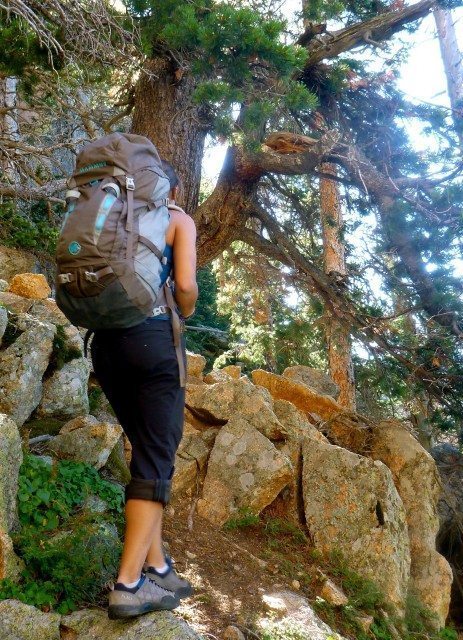
Five Ten Women’s Guide Tennie
Sizes: 5-10
Size Tested: 6
Stated Weight: 14.4 oz / 408.96 G Ea. (Size 9)
Features
- Upper: Nubuck Leather
- Closure: Lace
- Outsole: Stealth C4 Dotty
Reviewer’s Feet: 225mm long; 89mm wide
MSRP: $115
Days Tested: About 30
Locations Tested: Chiracahua Mountains, NM; Old Stage Road, Shelf Road, Sawatch Range, and Independence Pass, CO; Southeast Arizona; and around various towns
When it comes to approach shoes, there are a few products—such as the Five Ten Guide Tennie, the La Sportiva Boulder X, and the Scarpa Crux—that really stand out. Indeed, the Guide Tennie and the Boulder X have developed almost cult-like followings.
In an effort to better understand the strong feelings surrounding each pair, I reviewed both shoes. And it turns out that although they’re similar, they each have different strengths and weaknesses. (Be sure to check back tomorrow for the review of the Boulder X.)
I have friends who swear by the Guide Tennie. They say that it’s the stickiest approach shoe around, and the best when it comes to scrambling around on rock. I know other climbers who will only wear the Boulder X. So what’s the fuss about?
Let’s find out.
Fit
While the areas around the ankle and the tongue are heavily padded, the Guide Tennie overall has less cushion than the Boulder X. The Tennie’s upper is pretty thin, which makes for a solid, functional shoe rather than an ultra-comfortable one. This shoe also has a lot more volume (from the top-to-bottom of my foot) than the Boulder X, making it easier for me to comfortably fit arch support inserts.
The Guide Tennie is slightly lower and looser around my ankle and heel than the Boulder X—the top of the shoe sits just below my ankle bone. This makes it feel like a cross between a trail runner and a light hiking boot. However, it still has an “average-sized” sole, so it still doesn’t feel like a super light piece of footwear. My heel sits about ¾” above the ground, while the sole beneath the toe is about ⅜” high.
The toe box is rounded and fairly roomy (both horizontally and vertically), making the Guide Tennie feel less like a climbing shoe than the Boulder X. But it’s not so large that I was sloshing around. The shoe is tight around the midfoot without being constricting, and the toe feels stiff for edging.

Sizing
The Guide Tennie fits true to size; I generally wear about a size 5 or 6 street shoe, and I bought the size 6 Tennie. It does, however, run about a ½ size larger than the typical Five Ten climbing shoe scale. For example, I found my Anasazi LV to fit tighter than expected—the Guide Tennie doesn’t follow this trend.
Features
The Guide Tennie’s upper is made out of leather, while the interior fabric is largely canvas. This doesn’t make the shoe particularly breathable, but personally I haven’t found this to be much of a drawback, even in the heat of southeast Arizona. And while the shoe might not be very breathable, it is very durable. (More on this below.)
One of the notable new features of the 2013 Guide Tennie is the addition of rubber around the corner of the pinky toe area. Historically, the Tennie would wear out (to the point of small holes) in this corner, and Five Ten has tried to fix that problem by beefing up the area.
I haven’t worn the Tennie into the ground—I’ve put in about 30 days on trails, rock, and snow, and I’m typically not too abusive of my footwear—so I have yet to see whether this change is helpful. But many of my die-hard Guide Tennie enthusiast friends are excited about it.

One feature I’m particularly excited about is the laces. Rather than having traditional straight laces, the Guide Tennie has laces that are lumpy, with alternating constrictions and bulges throughout. This makes it much harder for the laces to come untied while climbing and scrambling around.
Technical Terrain
The Guide Tennie is the premier approach shoe when it comes to actual rock climbing. It has a very sticky outsole (thank you, Stealth C4 Rubber), and it smears and edges marvelously.
The shoe doesn’t, however, do well on wet, icy, or otherwise slippery terrain. The lack of tread (other than the little dots that cover the sole) renders it pretty ineffective in wet conditions. I wouldn’t recommend the Guide Tennie for varied terrain or long approaches for this reason.

I took the Tennie on one approach up Old Stage Road in Colorado Springs, where I really put them to the test—the area was still covered in snow. The hike involves a steep, off-trail 1/4-mile slog before you hit another 1/4 mile of steep, downhill talus. The Guide Tennie struggled to maintain traction both in the snow and on the rock.
Durability
In my time using the Guide Tennie, I haven’t noticed any durability isses. I am curious to see how it wears, especially around the pinky toe area, over a more extended period of time.
Bottom Line
The Guide Tennie is probably the single best shoe on the market for guide climbing and for situations where you need to climb easy routes and don’t want to deal with switching shoes all the time.
They excel at steep climbing and all high-friction terrain. They are ideal for cragging days and short trips, but are a bit too light for extended trips, long approaches, or any route involving snow.
